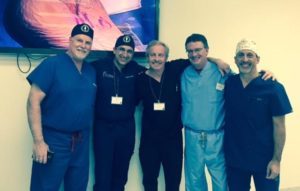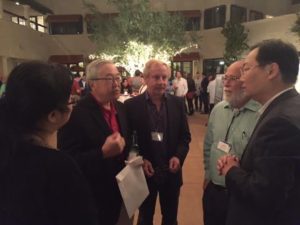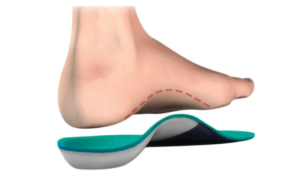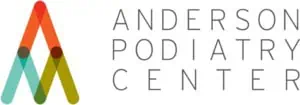-
ESTIM
ESTIM
Electrical nerve stimulation (ESTIM) is a non-surgical treatment that involves the injection of a local anesthetic followed by the application of an electronic signal treatment that sends electrical pulses into the foot or lower extremity using electrodes.
The electrical nerve stimulation activates the release of natural pain-suppressing modulators and causes microcirculation to improve healing—its effect is similar to rebooting a malfunctioning computer.
Estim is effective in treating:
- Neuropathy
- Restless Legs Syndrome
- Chronic Pain
Multiple treatments are required to determine their effectiveness. Your doctor will determine via exam and consultation the best treatment plan for you. A majority of patients experience significant relief.
Anderson Podiatry Center is excited to offer this cutting-edge solution that adds to our ability to offer complete, individualized treatment options to our patients and contributes to our standing as a leader in comprehensive treatment centers.
Learn more about the treatments available from Anderson Podiatry Center.
-
Interoperative Nerve Monitoring
The concept of monitoring nerve function during nerve surgery has long been used with head, neck and spinal surgery, but has not been considered for lower extremity surgical cases. At Anderson Center For Neuropathy & Chronic Pain we were the first to utilize this concept. If it’s good enough for the head, neck, and back it should be good enough for the foot and lower extremity!
So, how is it used? To reverse the life-altering symptoms of neuropathy and restless legs.
- We open nerve tunnels that are causing too much pressure and injuring your nerves. While the surgery is being performed the Nerve Integrity Monitor (NIM ®) machine (the leading nerve monitoring system used in most of the hospitals in the US and created by Medtronic), monitors the progress of the surgery.
- We take measurements before and after the tunnel is opened. We then have a paper report of how much the nerve function improved in the operating room. It’s very exciting to see as much as 300 percent improvement in some patients!
- This reported improvement in the operating room translates to functional improvement for the patient, oftentimes in terms of dramatically improved and even reversed symptoms of neuropathy (numbness, tingling, burning sensations) and restless legs.
- We share this information with the patient immediately after surgery, much to their delight.
- We also use the data collected to do studies which are being used to demonstrate to the rest of the medical world that our procedures have a very positive effect for those suffering from neuropathy or restless legs.
- The following are some facts that Medtronic would like you to know, to help you understand the significance of what we do. They are excited about our results and consider it an important contribution to the medical community:
- Anderson Center For Neuropathy & Chronic Pain is the first facility to integrate intraoperative nerve monitoring into lower extremity surgery.
- We perform more intraoperative nerve monitoring procedures than anyone in the Rocky Mountain region, and possibly the country.
- We are helping to pioneer the concept of intraoperative nerve monitoring use in the lower extremity, in conjunction with Medtronic.
- Our experience has shown us that monitoring nerve function during surgery gives us the best opportunity to optimize improved nerve function.
- Nerve monitoring reduces the risk of intraoperative nerve injury (according to research by the International Neuromonitoring Society for Thyroid Surgery)
- Intraoperative Nerve Monitoring provides feedback to the surgeon for more complete nerve treatment
Speak to one of our doctors today to learn more about intraoperative nerve monitoring. We feel it’s a useful tool and can help to improve the outcome of the procedures that we do for neuropathy and restless leg symptoms.



Photos of Dr. Anderson at the Association of Extremity Nerve Surgeons Conference where they discussed Anderson Podiatry Center’s revolutionary Intraoperative Nerve Monitoring procedure. -
Orthotics
Foot orthotics are custom-made shoe inserts that are designed to correct abnormal or irregular foot or leg biomechanics.
Click here for more information on orthotics:
‘Three Reasons Custom Orthotics Work’
Custom Orthotics vs. Over-the-Counter Arch SupportsSometimes called arch supports, foot orthotics allow people to stand, walk, and run more efficiently and comfortably and correct improper biomechanics that can lead to injury or pain.
About Orthotics
Foot orthotics come in many shapes and materials. A wide range are available with different design and flexibility options that accommodate many shoe styles and foot types.
Foot orthotics are used for early intervention and treatment of conditions such as:
 Plantar fasciitis
Plantar fasciitis- Tendonitis
- Arthritis
- Bunion pain
- Neuroma pain
- Shin splints
- Callouses
- Flat feet
- Knee pain
- Back pain
Benefits
While over-the-counter foot orthotics are available and may help people with mild symptoms, they normally cannot correct the wide range of symptoms that prescription foot orthotics can. Prescription orthotics are custom made to fit an individual’s unique foot structure.
This is done by taking a non-weight bearing computerized scan of each foot while it is placed in an optimized, biomechanically correct position by our trained technicians.
The doctors at Anderson Podiatry Center have extensive experience in diagnosing conditions best suited for treatment by orthotics and also in prescribing the type of orthotic that best addresses your particular activity, shoe gear, and foot type.
-
Endoscopic Surgery
Endoscopic Surgery
Endoscopic surgery is minimally invasive surgery that can often be used in place of traditional open surgery. It may be used to treat some conditions in which conservative treatment failed to provide relief.
Doctors performing endoscopic surgery use a long, flexible tube with a camera and a light attached at the end. While the camera can often enable a surgeon to more closely see the surgical area, especially in the small areas of the foot, procedures should be performed by well-trained and experienced foot surgeons like the doctors at Anderson Podiatry Center.
It can be used to treat:
- Severe cases of plantar fasciitis
- Tarsal tunnel conditions (nerve release surgery)
With endoscopic surgery, operations are less traumatic, incisions are smaller, recovery is quicker, and there are fewer side effects.
Learn more about the treatments available from Anderson Podiatry Center.
-
Laser Therapy for Toenail & Fingernail Fungus
Laser Therapy for Toenail & Fingernail Fungus
Fungal nails are usually more resistant and more difficult to treat than Athlete’s foot.
As many of those with stubborn toenail or fingernail fungus have found out, topical or oral antifungal medications are typically better at preventing infection than treating it.
Laser therapy for nail fungus can be extremely effective in treating fungus for both the fingernails and toenails.
The doctors at Anderson Podiatry Center are specially trained to medically evaluate and treat nail fungus.
The Pinpointe Foot Laser is the first FDA-approved laser for treating this stubborn condition and it is specifically designed for use on nails, unlike multi-use lasers, with a high rate of effectiveness.
Learn more about the treatment available from Anderson Podiatry Center.
-
MLS Laser Therapy
MLS Laser Therapy
MLS® Laser Therapy is an exciting new laser therapy cleared by the FDA as a treatment for a wide range of injuries and conditions that cause pain.
The doctors at Anderson Podiatry Center are excited to add this state-of-the-art treatment option to our available therapies.
The many benefits of MLS Laser Therapy include:
Anti-inflammatory: MLS Laser Therapy has an anti-edema effect in swelling caused by bruising or inflammation.
Analgesic: MLS Laser Therapy has a beneficial effect on nerve cells that decreases nerve sensitivity, edema, and pain.
Accelerated Tissue Repair and Cell Growth: The light from MLS lasers penetrates deeply into tissue and accelerates cellular reproduction and growth; damaged cells are repaired faster.
Improved Vascular Activity: Laser light significantly increases the formation of new capillaries in damaged tissue, which speeds up the healing process, closes wounds quickly, and reduces scar tissue.
Trigger Points and Acupuncture Points: MLS Laser Therapy stimulates muscle trigger points and acupuncture points on a noninvasive basis to provide musculoskeletal pain relief.
Reduced Fibrous Tissue Formation: MLS Laser Therapy reduces the formation of scar tissue following tissue damage from cuts, scratches, burns, or surgery.
Improved Nerve Function: Slow recovery of nerve functions in damaged tissue can result in numbness and impaired limbs. Laser light speeds the process of nerve cell reconnection and optimizes muscle and nerve healing.
Immunoregulation: Laser light stimulates immunoglobulins and lymphocytes and enhances cell energy.
Faster Wound Healing: Laser light stimulates fibroblast development in damaged tissue. As a result, MLS Laser Therapy is effective post-surgically and in the treatment of open wounds and burns.
MLS Laser is used to treat:
- Shoulder and neck pain
- Rotator cuff
- Back pain
- Carpal tunnel syndrome
- Sciatica
- Aching knees
- Achilles tendonitis
- Plantar fasciitis
- Neuropathy or restless legs
- or any other musculoskeletal pain
Learn more about the treatments available from Anderson Podiatry Center.
-
Nerve Decompression Surgery
The doctors at Anderson Center for Nerve Pain are among few experts who specialize in treating chronic pain due to various types of conditions and injuries to peripheral nerves. We treat neuropathy, restless leg syndrome and drop foot, as well as other chronic nerve pain conditions throughout the body with groundbreaking new surgical procedures.
If your pain is due to injury or entrapment of one or more peripheral nerves, or from previous surgery, then there is a very high chance that we can help.
Nerve decompression surgery opens the tight area through which the affected nerve travels. This gives the nerve more room and allows blood to flow better in the nerve, as well as providing relief from the pressure that also detrimentally affect nerves.
